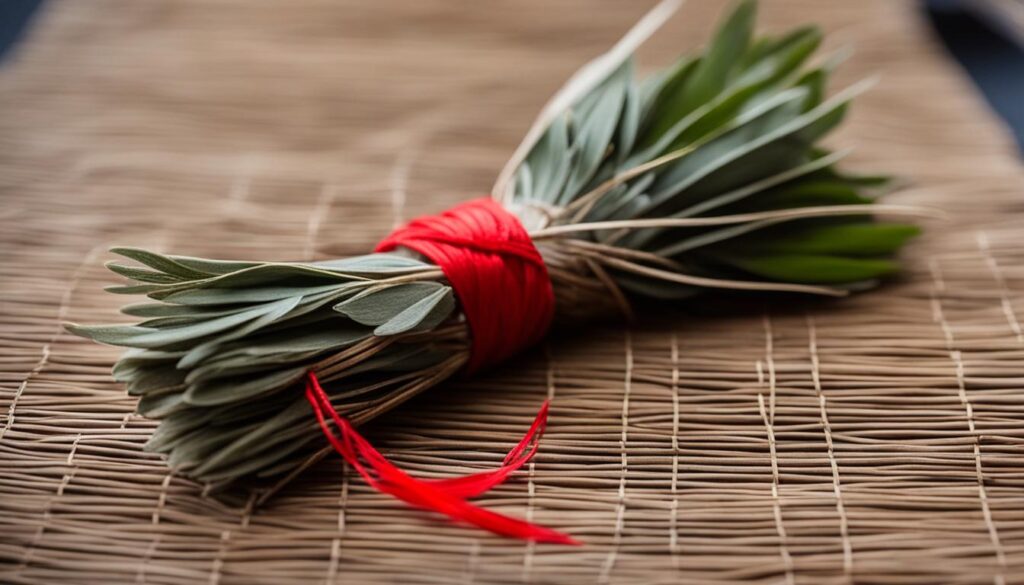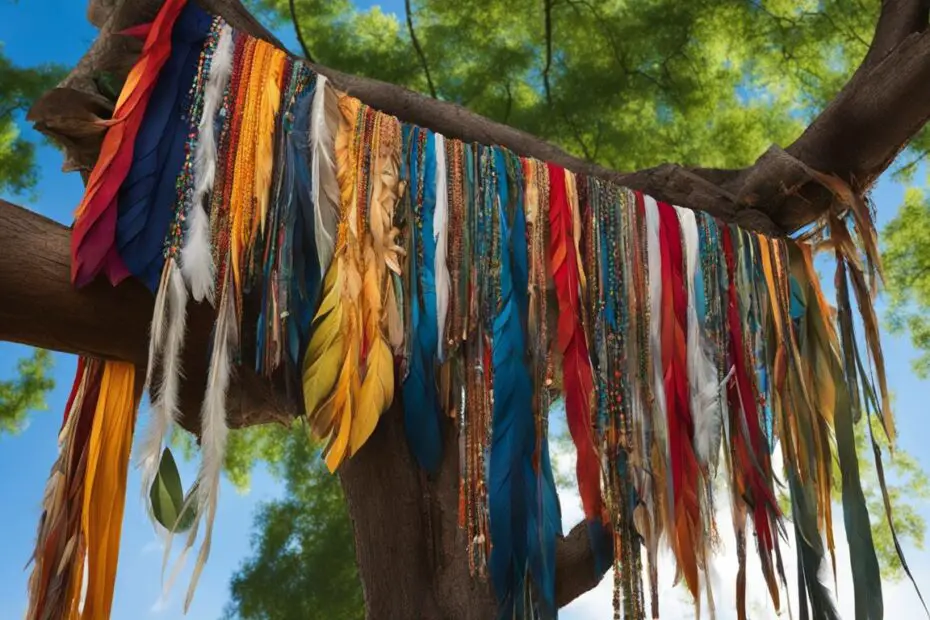Prayer ties are an integral part of various cultures, particularly in Native American spirituality. They serve as a bridge between the physical and spiritual worlds, allowing individuals to connect with spiritual beings and seek healing, guidance, and blessings through prayer rituals and ceremonies.
Key Takeaways:
- Prayer ties are a significant aspect of Native American spirituality and serve as a connection between the physical and spiritual realms.
- These prayer tools symbolize intentions and prayers, with each tool holding its own significance.
- There are variations in prayer ties among different sects and cultures, highlighting the diversity of spiritual practices worldwide.
- Prayer ties are often made using natural materials like fabric or leather, emphasizing the harmony between humans and the natural world.
- The use of prayer tools, including prayer ties, has evolved over time to adapt to societal changes while maintaining their core purpose.
The Significance of Prayer Tools in Practice
Prayer tools play a vital role in the practice of prayer ties. These tools, such as feathers, beads, and fabric, are used to create the physical representation of a prayer tie, allowing individuals to establish a spiritual connection and channel their intentions and prayers to the spiritual realm. Each prayer tool holds its own symbolism, representing different aspects of the individual’s prayers and enhancing the spiritual experience.
Feathers, for example, are often used in prayer ties to symbolize spirituality and divine connection. They are believed to carry messages between the physical and spiritual worlds. Beads, on the other hand, can represent different intentions or prayers. Each color or type of bead may hold a specific meaning, such as healing, protection, or gratitude. Fabric, which is used to tie the prayer tools together, acts as a physical anchor for the prayers and intentions, reinforcing their significance.
Through the use of these prayer tools, individuals are able to deepen their spiritual practice and strengthen their connection with the divine. The act of selecting and incorporating specific prayer tools into a prayer tie allows individuals to infuse their intentions with symbolism, bringing added depth and meaning to their prayers. These tools serve as tangible reminders of the spiritual journey and the power of faith.
To further illustrate the significance of prayer tools in practice, let’s take a look at the following table:
| Prayer Tool | Symbolism |
|---|---|
| Feathers | Represent spirituality and communication with the divine |
| Beads | Hold specific meanings based on color or type, such as healing or protection |
| Fabric | Acts as a physical anchor for prayers and intentions, reinforcing their significance |
As seen in the table above, each prayer tool carries its own symbolism, contributing to the overall spiritual connection and intention of the prayer tie. These tools are carefully selected and incorporated into the prayer tie to enhance the individual’s spiritual experience and deepen their connection with the divine.
Variations Among Sects and Cultures
Prayer ties exhibit variations among different sects and cultures, reflecting the diverse ways in which spiritual practices are expressed. While the purpose remains the same – to establish a connection with the spirit realm – the specific practices, symbolism, and traditions associated with prayer ties can differ significantly.
Native American Prayer Ties
Native American prayer ties are deeply rooted in their cultural heritage and hold unique symbolism. These prayer ties often use specific colors, patterns, and materials that hold cultural significance. For example, the use of the four colors representing the cardinal directions – red, yellow, black, and white – symbolizes connection with the spiritual world, nature, and the cosmos. Each color carries its own meaning and intention in prayer. Furthermore, different tribes may have their own distinct prayer tie traditions and customs, emphasizing the rich diversity within Native American spirituality.
Other Sects and Cultures
Beyond Native American traditions, other sects and cultures have their own variations in prayer ties. For instance, in Tibetan Buddhism, prayer ties called “Lungta” are made using five colors that represent the five elements and are believed to carry prayers and intentions when hung in sacred places or tied to prayer poles. In Hinduism, prayer threads called “Mauli” are tied around the wrist during ceremonies and symbolize protection and the blessings of deities. These examples demonstrate how prayer ties adapt and evolve to reflect the unique practices and beliefs of different sects and cultures.
Embracing Diversity
The variations in prayer ties among sects and cultures highlight the importance of embracing diversity in spiritual practices. They invite us to recognize and respect the richness of different traditions and the ways in which they honor and connect with the divine. By understanding these variations, we can deepen our own spiritual understanding and foster a greater appreciation for the interconnectedness of all spiritual paths.
Materials Used for Prayer Ties
Prayer ties, being deeply rooted in nature and spirituality, are often made using natural materials that hold symbolic significance. The choice of materials for prayer ties can vary depending on cultural traditions and personal preferences. Common materials include fabric, cloth, and leather. These materials not only serve as a physical representation of prayers but also reflect the connection between humans and the natural world, emphasizing the importance of harmony and respect for the environment in spiritual practices.
“The materials used for prayer ties play a crucial role in conveying intentions and prayers to the spiritual realm”
“When making prayer ties, I always choose natural fabrics like cotton or silk. Cotton represents purity and softness, while silk symbolizes luxury and spiritual purity. I believe that using natural materials helps me establish a stronger connection with the divine and infuse my prayers with sincerity and authenticity.” – Sarah, a practitioner of prayer ties
Prayer ties made from fabric can be adorned with different colors that hold their own symbolism:
| Color | Symbolism |
|---|---|
| Red | Strength, energy, and courage |
| Yellow | Clarity, optimism, and enlightenment |
| Blue | Peace, calmness, and spiritual growth |
| Green | Abundance, healing, and fertility |
These colors can be combined or used individually based on the intentions of the individual creating the prayer tie. Other materials, such as feathers, beads, or natural fibers, can also be added to prayer ties to enhance their symbolism and spiritual connection.
Evolution of Prayer Tools Over Time
Prayer tools, including prayer ties, have evolved over time in response to changes in society and the influence of modernization and globalization. While the core purpose of prayer ties remains unchanged – establishing a spiritual connection and expressing intentions and prayers – the tools themselves may have undergone changes or adaptations.
“As our world becomes more interconnected and diverse, spiritual practices have also evolved to meet the needs of individuals seeking deeper connections with the divine,” explains spiritual teacher and author, Sarah Thompson. “Prayer tools, like prayer ties, have adapted to incorporate modern materials and symbols while still honoring the traditions and teachings of the past.”
One noticeable change in prayer tools is the use of different materials. While traditional prayer ties were often made from fabric or leather, modern prayer tools may incorporate synthetic materials or even recycled items to align with sustainable practices. This evolution reflects a growing awareness and consideration for the environment, as well as the need for prayer tools to be accessible to individuals with various cultural backgrounds.
Additionally, the symbols and designs on prayer tools have also evolved. While traditional prayer ties may have featured traditional colors or patterns passed down through generations, contemporary prayer tools may incorporate symbols that resonate with a broader audience. This inclusivity allows individuals from diverse backgrounds to find meaning and connection through prayer tools, regardless of their cultural heritage.
| Evolution of Materials | Evolution of Symbols and Designs |
|---|---|
| – Traditional materials: fabric, leather | – Traditional symbols: culturally specific colors, patterns |
| – Incorporation of synthetic materials | – Inclusion of universal symbols: peace, love, unity |
| – Use of recycled or sustainable materials | – Adaptation to individual preferences and beliefs |
The evolution of prayer tools reflects the dynamic nature of spirituality and the need for practices to resonate with individuals in different contexts. This evolution not only allows for personal expression within spiritual traditions but also encourages a deeper understanding and connection with the divine.
“The changes in prayer tools highlight the ongoing conversation between tradition and innovation,” remarks anthropologist Dr. Rachel Garcia. “While some may view these changes as a departure from tradition, they can be seen as a way to ensure the relevancy and accessibility of spiritual practices in our rapidly changing world.”
Ultimately, the evolution of prayer tools demonstrates the adaptability of spiritual practices and their ability to meet the needs of individuals in different cultural, social, and historical contexts. By embracing these changes while honoring the essence and intention behind prayer tools, individuals can continue to find solace, guidance, and connection through the timeless practice of prayer ties.
Lesser-Known Prayer Tools
While prayer ties are a well-known and widely used tool in various spiritual traditions, there are also lesser-known prayer tools that hold unique significance and purpose. These tools, often rooted in ancient wisdom and practices, offer individuals additional means to deepen their spiritual connection and enhance their prayer rituals.
One such lesser-known prayer tool is the sacred stone. Stones have long been regarded as powerful conduits of energy and are believed to possess their own unique vibrations and healing properties. In spiritual practices, these stones are selected based on their specific qualities and intentions. For example, amethyst is often associated with spiritual growth and protection, while rose quartz is linked to love and compassion.
Another lesser-known prayer tool is the use of herbs. Various cultures have utilized the healing and spiritual properties of herbs for centuries. These herbs, such as sage, cedar, or lavender, are often burned as part of cleansing rituals or used in sacred ceremonies to purify and prepare the space for prayer and connection with the divine.
| Prayer Tool | Significance |
|---|---|
| Sacred Stones | Believed to possess unique vibrations and healing properties |
| Herbs | Used in cleansing rituals and to purify the space for prayer |
“The use of lesser-known prayer tools adds depth and variety to spiritual practices, allowing individuals to explore different avenues of connection and intention-setting. These tools provide a tangible way to engage the senses and create a sacred space for prayer.”
It’s important to note that the selection and use of these lesser-known prayer tools may vary among different cultures and traditions. Each tool carries its own symbolism and significance, and individuals may choose to incorporate them into their prayer rituals based on personal beliefs and practices.
By embracing and exploring these lesser-known prayer tools, individuals can expand their spiritual practices and discover new ways to deepen their connection with the divine.

Cultural Preservation Through Prayer Ties
Prayer ties play a significant role in the cultural preservation of traditional indigenous practices, particularly in Native American spirituality. By practicing and passing down the tradition of prayer ties, communities can maintain a connection to their ancestral roots and preserve their cultural heritage. The act of creating and offering prayer ties is a way for individuals to honor their spiritual beliefs and strengthen the bonds within their community.
The use of prayer ties in Native American spirituality is deeply rooted in the belief that these sacred objects serve as a bridge between the physical and spiritual worlds. They are seen as a tangible representation of the individual’s prayers and intentions, allowing them to connect with spiritual beings and seek healing, guidance, and blessings. Through the practice of prayer ties, the spiritual traditions and teachings of Native American cultures are passed down from generation to generation, ensuring their preservation and continuation.
Prayer ties hold not only cultural significance but also serve as a means of spiritual connection. They provide individuals with a physical and symbolic tool to express their deepest intentions and prayers. By incorporating prayer ties into their spiritual practice, individuals can cultivate a sense of unity and connection with the divine, reinforcing their spiritual beliefs and values.
Table: Variations in Prayer Ties Among Native American Cultures
| Culture | Symbolism | Materials Used |
|---|---|---|
| Navajo | Colors representing the four sacred directions | Wool, cotton, or leather |
| Lakota Sioux | Specific numbers of prayer ties representing important spiritual concepts | Cloth and tobacco |
| Hopi | Sacred symbols representing elements of nature and ancestral wisdom | Yucca fiber and corn husks |
The Sacred Symbols of Prayer Ties
Prayer ties are not just physical objects; they are adorned with sacred symbols that hold deep spiritual meaning. These symbols serve as a visual representation of the intentions and prayers tied within the cloth. Each sacred symbol carries its own significance, representing different aspects of the spiritual world and conveying specific prayers or intentions. They add layers of depth and understanding to the practice of prayer ties, creating a powerful spiritual connection.
The Symbols Used in Prayer Ties
There are various symbols used in prayer ties, each with its own unique meaning. Geometric patterns are often incorporated, representing the interconnectedness of all things. These patterns can include circles, squares, or triangles, symbolizing unity, harmony, and balance.
Animal motifs are another common symbol found in prayer ties. Different animals hold different spiritual qualities, and their inclusion in prayer ties can represent specific prayers or intentions. For example, an eagle feather may symbolize strength and courage, while a butterfly symbolizes transformation and growth.
Nature is also a significant source of inspiration for the symbols used in prayer ties. Elements such as the sun, moon, stars, and flowers are often depicted to represent the divine presence and the cycle of life. These symbols serve as a reminder of the sacredness of the natural world and our connection to it.
Table: Symbolism in Prayer Ties
| Symbol | Meaning |
|---|---|
| Geometric patterns | Unity, harmony, balance |
| Animal motifs | Spiritual qualities, prayers or intentions |
| Nature | Divine presence, cycle of life |
These sacred symbols in prayer ties hold deep spiritual significance and are a powerful means of expressing intentions and connecting with the divine. They embody the rich traditions and cultural practices associated with prayer ties, inviting individuals to embark on a spiritual journey of healing, guidance, and transformation.
The Healing Power of Prayer Ties
Prayer ties are not only a means of spiritual connection and expression but also a powerful tool for healing. Through the act of creating and offering prayer ties, individuals can experience deep healing on physical, emotional, and spiritual levels. The process of making prayer ties involves mindfulness, intention setting, and the infusion of positive energy into each tie, which contributes to the healing process.
Traditional healing techniques often involve the use of prayer ties to address various ailments and imbalances. The act of tying each prayer tie represents a commitment to healing and serves as a tangible reminder of the intentions and prayers being offered. The individual’s focused attention and energy directed towards each tie enhances the healing potential and helps to establish a strong connection with the divine.
In Native American spirituality, prayer ties are believed to carry the prayers and intentions of the individual to the spirit realm, where they can be received and manifested. The physical act of offering prayer ties is seen as a form of surrender, trusting in the higher power to guide the healing process. This surrender allows individuals to release attachments, fears, and negative energies, creating space for healing and transformation.
Table: Prayer Ties and Their Healing Focus
| Prayer Tie Color | Healing Focus |
|---|---|
| White | Physical healing, purification |
| Blue | Emotional healing, peace |
| Green | Healing and balance in relationships |
| Yellow | Mental clarity, focus, and guidance |
| Red | Passion, vitality, and energy |
Prayer ties are not only a physical representation of our prayers but also a way to reconnect with our own divine essence and the healing power within us.” – Anonymous practitioner
The healing power of prayer ties goes beyond physical ailments. They can also address emotional wounds, trauma, and imbalances in relationships. The act of tying prayer ties while focusing on specific intentions helps individuals confront and release emotional blockages, facilitating the healing of emotional wounds and fostering inner peace.
Ultimately, prayer ties provide individuals with a tangible and accessible tool for healing on multiple levels. They serve as a reminder of the power of prayer, faith, and connection to the divine. The act of creating and offering prayer ties allows individuals to actively participate in their healing journey and embrace the transformative potential of spiritual practices.

Sacred Offerings and Intentions
When creating prayer ties, individuals often make sacred offerings to accompany their prayers. These offerings are chosen carefully and hold deep spiritual significance, serving as a way to honor and respect the spiritual beings being addressed in the prayers. Some common sacred offerings include tobacco, sweet grass, or other traditional substances that hold special meaning in different cultures.
The act of making an offering alongside prayer ties reinforces the intentions and prayers, symbolizing the sincerity and devotion of the individual. It is a way of showing gratitude and establishing a connection with the divine. These offerings are believed to carry the prayers and intentions to the spiritual realm, amplifying their power and significance.
By making sacred offerings, individuals not only demonstrate their reverence towards the spiritual beings but also create a sacred atmosphere during prayer rituals. The act of offering something of value represents a deep level of commitment and belief in the power of prayer ties. It is a way to engage all the senses and create a tangible connection to the divine.
| Sacred Offering | Symbolic Meaning |
|---|---|
| Tobacco | Considered a sacred plant, tobacco is believed to carry prayers to the spirits and is often used as an offering in prayer ceremonies. |
| Sweet Grass | Symbolizing purification and healing, sweet grass is often burned as an offering to invite positive energy and blessings. |
| Sage | Used for smudging and purifying spaces, sage is often offered as a way to cleanse and purify the prayers and intentions. |
These sacred offerings, combined with the act of creating prayer ties, create a powerful and sacred space for individuals to connect with the divine, express their intentions, and seek guidance and blessings.
The Continued Relevance of Prayer Ties
Prayer ties have stood the test of time and continue to hold great relevance in modern spirituality. In a world that often feels disconnected and fast-paced, prayer ties offer individuals a tangible means of connecting with the divine and seeking guidance, healing, and connection. Despite the advancements in technology and the changes in societal norms, the practice of prayer ties remains a steadfast reminder of the power of faith and the importance of spiritual connection.
Modern spirituality is multifaceted, with individuals seeking a deeper understanding of themselves and the world around them. Prayer ties provide a sense of grounding and ritual in this journey of self-discovery. They serve as a physical representation of intentions and prayers, reminding individuals to slow down, reflect, and offer gratitude to the spiritual beings they address in their prayers.
Whether it’s through the act of creating prayer ties or the act of offering them, individuals find solace, peace, and empowerment. Prayer ties offer a sacred space for introspection and self-care, allowing individuals to nurture their spiritual well-being. In a world that often prioritizes material possessions and external achievements, prayer ties offer a counterbalance, reminding individuals of the importance of inner growth, connection with the divine, and alignment with their true selves.
The Power of Prayer Ties in Modern Society
The continued relevance of prayer ties lies in their ability to bridge the gap between the physical and spiritual worlds. They provide a tangible and personal connection with the divine, allowing individuals to tap into their intuition, draw strength from their spirituality, and find solace amidst the chaos of daily life. Prayer ties serve as a reminder that despite the challenges and uncertainties we face, there is a higher power that we can turn to for comfort, guidance, and healing.
| Benefits of Prayer Ties in Modern Spirituality |
|---|
| Deepens spiritual connection |
| Facilitates self-reflection and introspection |
| Provides a sense of grounding and ritual |
| Nurtures inner growth and personal development |
| Offers a means of seeking guidance and healing |
| Strengthens faith and cultivates gratitude |
Prayer ties have the power to transform and uplift individuals, reminding them of their innate connection with the divine and the importance of nurturing their spiritual well-being. In a world that may often feel disconnected and overwhelming, prayer ties provide a sacred space for individuals to seek solace, find clarity, and connect with the higher powers that guide and support them.

“Prayer is not asking. It is a longing of the soul. It is daily admission of one’s weakness. It is better in prayer to have a heart without words than words without a heart.” – Mahatma Gandhi
Conclusion
Prayer ties are a powerful and significant spiritual practice that serves as a bridge between worlds. They allow individuals to connect with the spiritual realm and express their intentions and prayers. Throughout various cultures, prayer tools such as feathers, beads, and fabric are used to create physical representations of prayer ties. These tools hold symbolic meaning, representing different aspects of the individual’s prayers and establishing a spiritual connection.
While prayer ties have a common purpose, there are variations among different sects and cultures. Native American prayer ties may use specific colors or patterns that hold cultural significance, while other traditions have their own unique customs and symbolism. The materials used for prayer ties often include natural fabrics and materials, emphasizing the connection between humans and the natural world.
Over time, prayer tools have evolved alongside societal changes. Modernization and globalization have influenced the adaptation of traditional prayer tools, but their core purpose remains unchanged. In addition to prayer ties, there are also lesser-known prayer tools such as sacred stones, herbs, and crystals, each with their own significance and purpose.
Prayer ties play a vital role in the preservation of cultural heritage, particularly in Native American spirituality. By practicing and passing down the tradition of prayer ties, communities can honor their ancestral roots and maintain a spiritual connection. The use of sacred symbols in prayer ties adds depth and understanding to the practice, fostering a powerful spiritual connection. In today’s modern world, prayer ties continue to be relevant and significant, offering individuals a means to seek meaning, healing, and connection with the divine.
FAQ
What is the significance of prayer ties?
Prayer ties serve as a bridge between the physical and spiritual worlds, allowing individuals to connect with spiritual beings and seek healing, guidance, and blessings through prayer rituals and ceremonies.
What materials are used to create prayer ties?
Prayer ties are often made using natural materials such as fabric, cloth, or leather. The choice of material can hold symbolic meaning and reflects the connection between humans and the natural world.
How do prayer ties vary among different cultures?
Prayer ties vary in their practices and symbolism among different sects and cultures. For example, Native American prayer ties may use specific colors or patterns that hold cultural significance, while other sects may have their own unique traditions and customs associated with prayer ties.
What other prayer tools are used in addition to prayer ties?
In addition to prayer ties, there are other lesser-known prayer tools used in various spiritual traditions, such as sacred stones, herbs, or crystals, each with its own significance and purpose.
How do prayer ties contribute to cultural preservation?
By practicing and passing down the tradition of prayer ties, communities can preserve their cultural heritage and maintain a connection to their ancestral roots. Prayer ties serve as a tangible representation of traditional indigenous practices and a way to honor and strengthen the spiritual bonds within the community.
What is the healing power of prayer ties?
The act of creating and offering prayer ties can be a deeply healing and transformative experience, providing individuals with a sense of peace, connection, and empowerment. Prayer ties can be used to seek physical, emotional, and spiritual healing.
What are sacred offerings in relation to prayer ties?
When creating prayer ties, individuals often make sacred offerings alongside their prayers, such as tobacco or sweet grass. These offerings symbolize the sincerity and devotion of the individual and serve as a way to honor and respect the spiritual beings being addressed in the prayers.
How do prayer ties remain relevant in modern spirituality?
Prayer ties continue to hold great relevance in modern spirituality by providing individuals with a tangible means to connect with the divine, seek guidance, and express their deepest intentions and prayers. They offer a sense of grounding and ritual in today’s fast-paced, technology-driven world.








